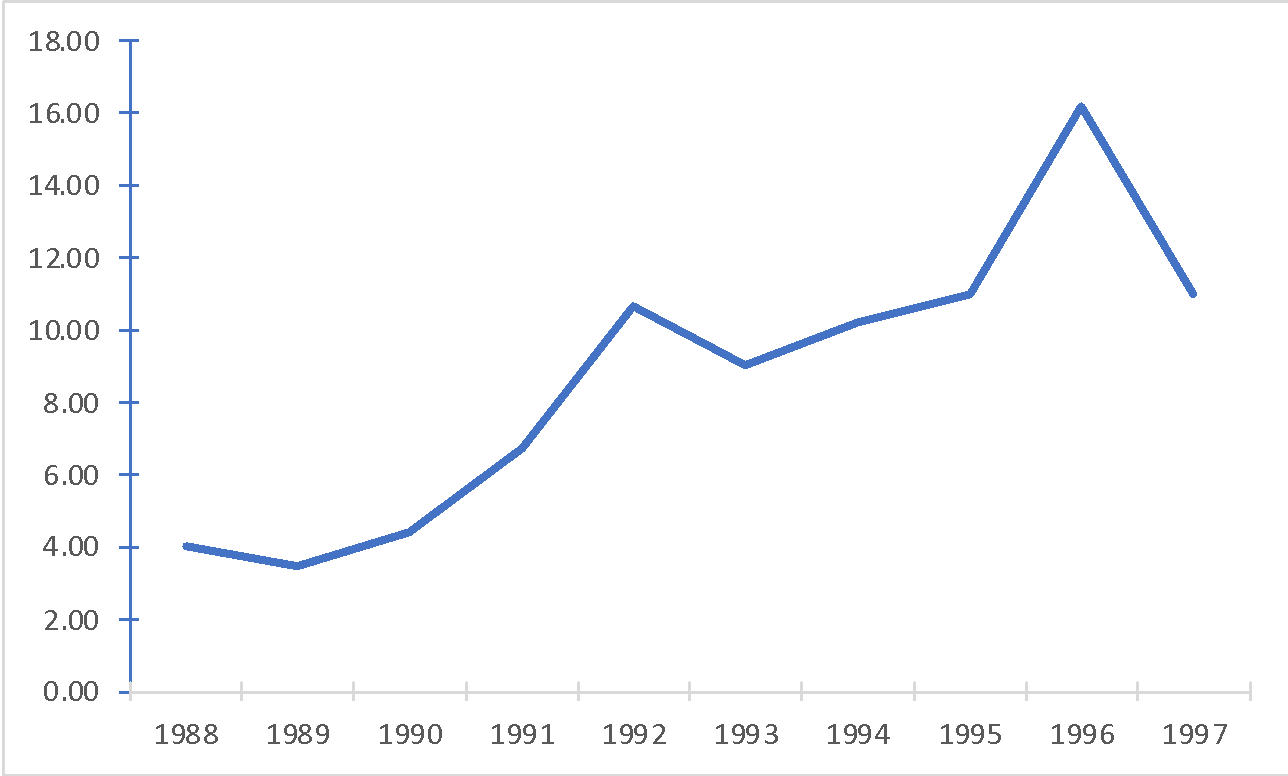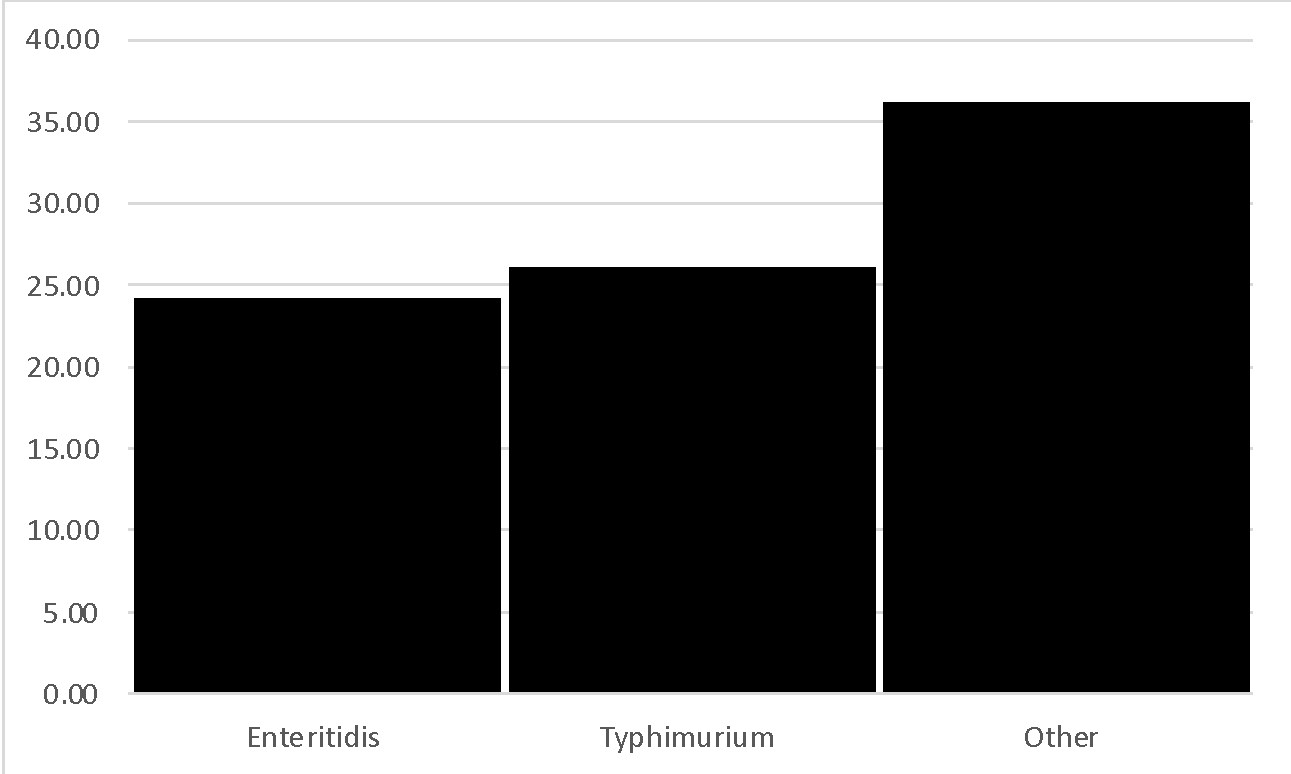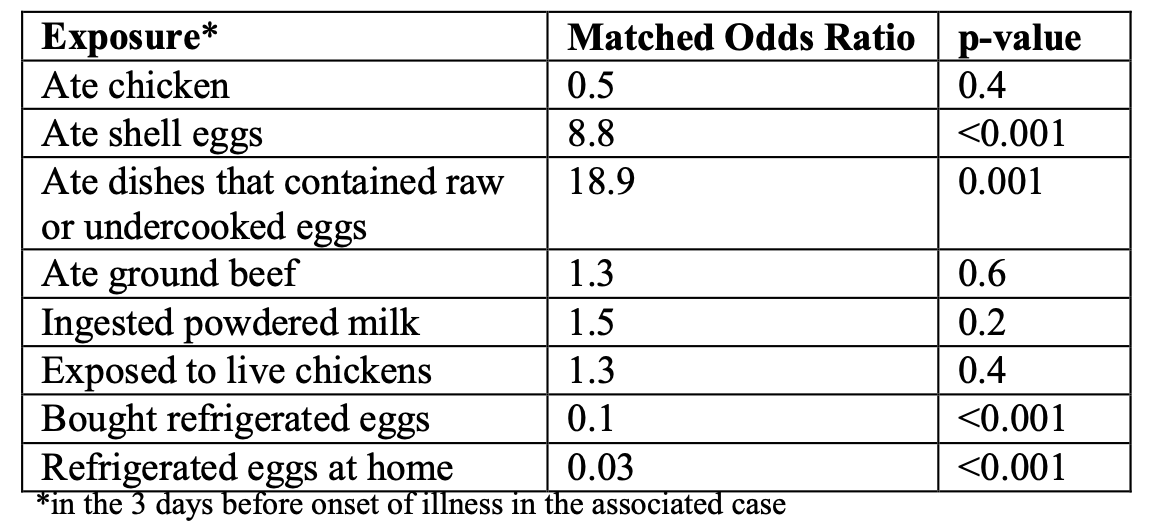Salmonellosis is a dangerous infectious disease of the mainly gastrointestinal tract, transmitted by the oral-facial way. The pathogen of the disease is several serotypes of the bacterium genus Salmonella from the family Enterobacteriaceae. Thus, the most frequent way of infection is associated with the consumption of poor-quality food or thermally unprocessed food, whether chicken eggs or steak meat. Thus, consumption of such food is considered one of the most critical risk factors. The course of the disease is generally individual: for some individuals, it may be asymptomatic, while for others, it may be a severe condition accompanied by severe dehydration and poisoning. For example, according to the case text, an initially weakened immune system — due to HIV, among others — can be a severe risk factor for a more severe course of the disease and even a focus of inflammation from the intestinal tract into the bloodstream. Finally, what is evident from the last two factors, the risk of infection may be increased by closer contact with Salmonella. In particular, this may include visiting other countries, especially those with poor sanitary conditions and low availability of medicine.
By the mid-1980s, according to the case text, Salmonella had become a very serious threat to Caribbean regions, affecting local people and tourists. This study used a qualitative method of collecting data from patients through interviews to determine the cause of infection. As a result, information was collected from various sources about the patients’ diet in the last days before infection. Among the most common foods reported were chicken, eggshells, meals that included uncooked all-chicken eggs, and powdered milk and beef. Some sources have reported infections from direct interaction with chickens, for example, on farms.
It is not hard to see that chicken and chicken eggs are not the least important in the spread of salmonellosis. In fact, chickens are thought to be a significant source of infection for humans because of their popularity as food and their high prevalence in agriculture as a valuable resource of meat and eggs. Salmonellae are sources of zoonotic diseases, and birds are often their reservoirs. For this reason, contact with poultry, particularly chicken feces and products, is dangerous for humans. However, it should be kept in mind that due to the multiplicity of forms of this bacterial genus, not all infected chickens will necessarily infect humans: there may be species that are dangerous only to birds, such as Salmonella gallinarum (Chen et al., 2020). Consequently, if the pathogen poses a threat to both birds and humans, there is a need for additional security. More specifically, heat treatment of eggs and food is required, as well as buying only from verified, certified suppliers to avoid the possibility of salmonellosis infection.
However, there is a misconception that salmonellosis is only transmitted through a chicken or its eggs. This is incorrect, and the case study confirms it well: Many of the patients had eaten ground beef the day before. Beef as a source of bacteria of the genus Salmonella is a potential threat of infection. In fact, this is not strictly true for beef but for all cattle. Consumption of raw, undercooked cow meat should also be considered a health hazard because some strains of the Salmonella genus infect cattle directly.
Notably, a cow’s product of high agricultural value, namely milk, can also pose a danger in terms of Salmonellosis infection. This applies to freshly milked milk and even dried milk used for culinary purposes. According to the FDA, up to five percent of dried dairy products on the market had a proven presence of bacteria of the genus Salmonella (Paswan, 2020). This is not surprising when one considers the way dried milk is produced: two types of milk are mixed, then steamed and dried. There is no solid thermal or enzymatic treatment in this procedure, so there is a chance that pathogenic forms of Salmonella will persist. In addition, any products containing this dried milk that have not been sanitized also have a risk to humans, whether dairy or confectionery products.
Based on the data that were presented in the case study, the following table was constructed:
In this table, the incidence rate was calculated for each year based on the total number of cases for specific strains of the bacterium. The total population for Trinidad and Tobago was taken as 1,265,000, so this number was taken for each year. Some examples from the calculations are shown below:

As can be seen in this case, the mortality rate has been gradually increasing, with peaks evident for mortality by some years, whether 1992 or 1996, as shown in the graph below. Consequently, the overall conclusion, in this case, is that the mortality rate gradually increased over a 10-year period, with a 273% increase in mortality at the end of this period compared to 1988.

In addition, a table was constructed for the prevalence of each of the three categories of strains, whether Enteritidis, Typhimurium, or other. The table below shows this value for each of the three serotypes. For Enteritidis it is 24.27, for Typhimurium it is 26.17, and for other it is 36.28.
Example calculations for each of the serotypes are shown below:



Or in the form of a histogram of frequencies:

The apparent maximum characteristic of the Other serotype is related to the multiplicity of this category. Unlike Enteritidis or Typhimurium, which describe the prevalence of only a unique strain of Salmonella, Other includes information about all other bacterial species. Therefore, the highest prevalence does not seem surprising for this serotype.
To calculate mortality for each serotype, the following calculations must be performed as shown below, for S. enteritidis:



Consequently, about four people out of 100,000 died each year from various salmonellosis infections. Then the total mortality rate:

Or for each individual case, depending on the serotype:



These calculations used a model called the mortality rate or simply mortality. Generally speaking, this is a measurement of how many people died from a given disease in a given year or over the course of years, as calculated here (WHO, 2019). Roughly speaking, this indicator shows how dangerous a given disease is, especially when calculated by demographic characteristics, be it age.
Patients were asked what foods they had consumed in the three days prior to the onset of symptoms. The data from this survey are shown in the table below:

In general, one can see that the highest values were characteristic of dishes that contained raw eggs (18.9), but also very high values were characteristic of chicken eggshells (8.8). The other food categories had fewer high ratios but could still pose a danger to humans. In general, if one ranks the above products in decreasing order of their ratios, one get the following list:
- Ate dishes that contained raw or undercooked eggs — 18.9
- Ate shell eggs — 8.8
- Ingested powdered milk — 1.5
- Ate ground beef — 1.3
- Exposed to live chickens — 1.3
- Bought refrigerated eggs — 0.1
- Ate chicken — 0.05
- Refrigerated eggs at home — 0.03
References
Chen, C., Li, J., Zhang, H., Xie, Y., Xiong, L., Liu, H., & Wang, F. (2020). Effects of a probiotic on the growth performance, intestinal flora, and immune function of chicks infected with Salmonella pullorum. Poultry Science, 99(11), 5316-5323.
Paswan, R., & Park, Y. W. (2020). Survivability of Salmonella and Escherichia coli O157: H7 pathogens and food safety concerns on commercial powder milk products. Dairy, 1(3), 189-201.
WHO. (2019). Mortality rate (per 100 000 population). WHO. Web.